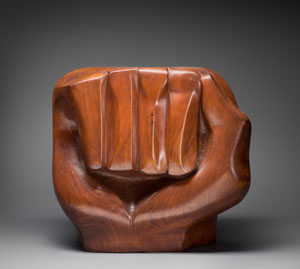7.28.25 — Community and Commitment
People remember Consuelo Kanaga for her sense of community and commitment. I remember the lonely eye behind the camera and the beauty of what she saw. Can either story bring her back into the mainstream of modern art?
Wherever she went, she found a movement in which she could believe. She had already made a name for herself in San Francisco in Group f.64, but she left for New York in her twenties to hook up with Alfred Stieglitz, her friend and mentor, and to join the Photo League, a cooperative that cared as much about social as creative causes.  The Brooklyn Museum opens her busy retrospective with a community at that, through August 3. A brief introduction sets her alongside an impressive roster of photographers, all of them women, who shared their progressive politics and took photographs of one another. You can see why Kanaga is known today mostly for portraiture, most notably of African Americans. Yet you may hardly notice she is there.
The Brooklyn Museum opens her busy retrospective with a community at that, through August 3. A brief introduction sets her alongside an impressive roster of photographers, all of them women, who shared their progressive politics and took photographs of one another. You can see why Kanaga is known today mostly for portraiture, most notably of African Americans. Yet you may hardly notice she is there.
As the show’s title has it, she was out to “Catch the Spirit“—the spirit of her sitters, the spirit of her times, and the spirit of the left. Yet the first image that may catch your eye as you enter is of lower Manhattan without a person in sight. It looks south with the Brooklyn Bridge nearly lost in a mist but light rippling down the water and spots of light piercing the morning air. She had an esthetics of control, from the large and then medium-format camera with which she began to her techniques of dodging, or burning a print with touches of light, and, every so often, touches by hand. Alfred Stieglitz, of course, had his own gallery, which enabled him to spread the word about modern art. And f.64 took its name from the sharpest setting on the camera back then, to capture every detail.
That small opening room itself suggests a dual or divided commitment. It includes Berenice Abbott and Imogen Cunningham, with their painterly photographs of the “new woman,” as well as Tina Modotti, who made mostly portraits (and sat for many more), and Dorothea Lange, with her memorable images of poverty and the New Deal. Born in 1894 (of Swiss ancestry, her Spanish first name notwithstanding), Kanaga was still going strong enough to seek out the artist community in Taos in 1955. That same year she contributed to The Family of Man, the photo essay by Edward Steichen. She photographed a mother and her children, just as Lange’s best-known image showed a migrant mother in 1936. She Is the Tree of Life to Them, Kanaga called it, when idealism still spread.
That division was not simply ambivalence, but a necessity. She started as a newspaper photographer, for the San Francisco Chronicle, but opened a portrait studio to make ends meet. Ironically, it has overshadowed everything else, enough to leave her all but forgotten. Even so, her style gives substance and unity to the whole. On the one hand, she contributed to The Daily Worker. On the other, she created purely abstract photography the year of her death, in 1978.
Not surprisingly, her portraits often run to creative types and to blacks. She found both in Langston Hughes, here at the center of the show’s largest section. He poses in profile, meticulously dressed. But then her portraits have much the same bag of creative tricks when it comes to the common man or woman. She loves wide eyes, hands held to the sitter’s cheeks, and shadows darkening a sitter’s brow. She was asking to recognize a subject’s dignity.
For all that, her commitments were as eclectic as ever, because the tree of life demands no less. She quickly switched to a smaller, more portable camera, bringing her artistry to small prints as well. Still, she was never a documentary photographer or street photographer, because she had no interest in spontaneity. She took to the rooftops, for a New Yorker’s favorite sight, the multiplicity of exhaust vents, just as her view of lower Manhattan had no people and nowhere to stand. She still traveled, to North Africa and Venice, closing in on the basilica cathedral of San Marco. Naturally she prefers the intricacy of its architecture to the commonality of its public square.
She has paid a price for her poses. They can become predictable and perilously close to hokey. Still, even the sentiment is heartfelt, and it can never erase her eclecticism and commitment. Are the folds covering a woman rags or flowers? Are young women leaning toward each other in seeming amazement strangers or twins? For a moment, the only spirit that matters is theirs.
Read more, now in a feature-length article on this site.
